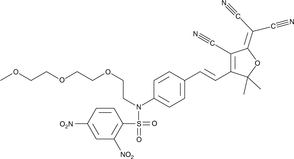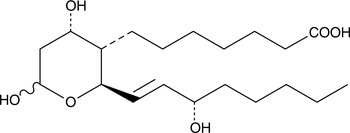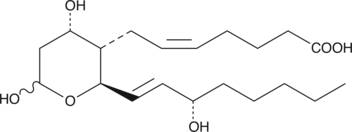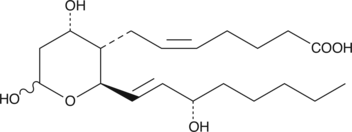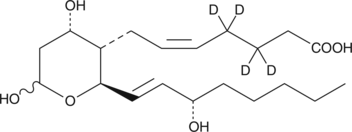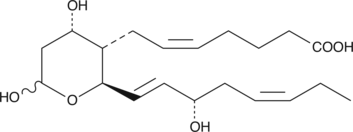Chemicals
Showing 37951–38100 of 41137 results
-
Thiocoraline is a depsipeptide and DNA bis-intercalator originally isolated from Micromonospora with antibacterial and anticancer activities.{53564,53565} It is active against the Gram-positive bacteria S. aureus, B. subtilis, and M. luteus (MICs = 0.05, 0.05, and 0.03 µg/ml, respectively) but not Gram-negative E. coli, K. pneumoniae, or P. aeruginosa (MICs = >100 µg/ml for all).{53564} Thiocoraline inhibits RNA and DNA polymerase and thymidylate synthase (IC50s = 6, 6, and 15 µg/ml, respectively), as well as RNA and DNA synthesis in vitro (IC50s = 0.008 and 0.4 µg/ml, respectively). It is cytotoxic to P388, A549, HT-29, and MEL-28 cancer cells (IC50s = 0.002, 0.002, 0.01, and 0.002 µg/ml, respectively).
Brand:CaymanSKU:29509 - 1 mgAvailable on backorder
Galectins are a family of glycan-binding lectins with diverse regulatory roles in physiological processes.{29013,29018} They have significant roles in inflammation and cancer.{29013,29018} Thiodigalactoside is a diglycan that binds galectins-1, -3, -8, and -9 with Kd values between 24 and 78 µM.{29017,29019} It is used to investigate the roles of these galectins in cell signaling and carcinogenesis.{29014,29015,29016}
Brand:CaymanSKU:-Out of stock
Galectins are a family of glycan-binding lectins with diverse regulatory roles in physiological processes.{29013,29018} They have significant roles in inflammation and cancer.{29013,29018} Thiodigalactoside is a diglycan that binds galectins-1, -3, -8, and -9 with Kd values between 24 and 78 µM.{29017,29019} It is used to investigate the roles of these galectins in cell signaling and carcinogenesis.{29014,29015,29016}
Brand:CaymanSKU:-Out of stock
Galectins are a family of glycan-binding lectins with diverse regulatory roles in physiological processes.{29013,29018} They have significant roles in inflammation and cancer.{29013,29018} Thiodigalactoside is a diglycan that binds galectins-1, -3, -8, and -9 with Kd values between 24 and 78 µM.{29017,29019} It is used to investigate the roles of these galectins in cell signaling and carcinogenesis.{29014,29015,29016}
Brand:CaymanSKU:-Out of stock
Galectins are a family of glycan-binding lectins with diverse regulatory roles in physiological processes.{29013,29018} They have significant roles in inflammation and cancer.{29013,29018} Thiodigalactoside is a diglycan that binds galectins-1, -3, -8, and -9 with Kd values between 24 and 78 µM.{29017,29019} It is used to investigate the roles of these galectins in cell signaling and carcinogenesis.{29014,29015,29016}
Brand:CaymanSKU:-Out of stock
Thiodiglycolic acid-d4 (TDGA-d4) contains four deuterium atoms at the 2, 2, 2’, and 2’ positions. It is intended for use as an internal standard for the quantification of TDGA by GC- or LC-mass spectrometry. TDGA is a product of interaction of the cysteine component of glutathione with two-carbon units released during catabolism. It is found in concentrations below 20 mg/l in urine of healthy individuals and elevated following ingestion of certain drugs.{30000} Determination of TDGA concentration in urine has been used to characterize the metabolism of substances participating in methionine synthesis in order to identify imbalances leading to hyperhomocystinuria.{29999} Additionally, because TDGA is used as raw material in the polymer industry, its detection in human urine has served as a biomarker for exposure to carcinogenic vapors such as vinylchloride monomer produced during polymer manufacture.{29999}
Brand:CaymanSKU:9002478 - 1 mgAvailable on backorder
Thiodiglycolic acid-d4 (TDGA-d4) contains four deuterium atoms at the 2, 2, 2’, and 2’ positions. It is intended for use as an internal standard for the quantification of TDGA by GC- or LC-mass spectrometry. TDGA is a product of interaction of the cysteine component of glutathione with two-carbon units released during catabolism. It is found in concentrations below 20 mg/l in urine of healthy individuals and elevated following ingestion of certain drugs.{30000} Determination of TDGA concentration in urine has been used to characterize the metabolism of substances participating in methionine synthesis in order to identify imbalances leading to hyperhomocystinuria.{29999} Additionally, because TDGA is used as raw material in the polymer industry, its detection in human urine has served as a biomarker for exposure to carcinogenic vapors such as vinylchloride monomer produced during polymer manufacture.{29999}
Brand:CaymanSKU:9002478 - 5 mgAvailable on backorder
Thiodiglycolic acid-d4 (TDGA-d4) contains four deuterium atoms at the 2, 2, 2’, and 2’ positions. It is intended for use as an internal standard for the quantification of TDGA by GC- or LC-mass spectrometry. TDGA is a product of interaction of the cysteine component of glutathione with two-carbon units released during catabolism. It is found in concentrations below 20 mg/l in urine of healthy individuals and elevated following ingestion of certain drugs.{30000} Determination of TDGA concentration in urine has been used to characterize the metabolism of substances participating in methionine synthesis in order to identify imbalances leading to hyperhomocystinuria.{29999} Additionally, because TDGA is used as raw material in the polymer industry, its detection in human urine has served as a biomarker for exposure to carcinogenic vapors such as vinylchloride monomer produced during polymer manufacture.{29999}
Brand:CaymanSKU:9002478 - 500 µgAvailable on backorder
Thioetheramide-PC is a structurally modified phospholipid that functions as a competitive, reversible inhibitor of secretory phospholipase A2 (sPLA2).{808,2624} The IC50 value for thioetheramide-PC is 2 µM at a substrate concentration of 0.5 mM.{808} In addition to binding to the catalytic site of sPLA2, thioetheramide-PC also binds to the activator site of this enzyme. The binding of thioetheramide-PC to the activator site is tighter than its binding to the catalytic site. The result of this dual interaction is that at low concentrations thioetheramide-PC may activate phospholipase activity rather than inhibiting it.{808}
Brand:CaymanSKU:62750 - 10 mgAvailable on backorder
Thioetheramide-PC is a structurally modified phospholipid that functions as a competitive, reversible inhibitor of secretory phospholipase A2 (sPLA2).{808,2624} The IC50 value for thioetheramide-PC is 2 µM at a substrate concentration of 0.5 mM.{808} In addition to binding to the catalytic site of sPLA2, thioetheramide-PC also binds to the activator site of this enzyme. The binding of thioetheramide-PC to the activator site is tighter than its binding to the catalytic site. The result of this dual interaction is that at low concentrations thioetheramide-PC may activate phospholipase activity rather than inhibiting it.{808}
Brand:CaymanSKU:62750 - 25 mgAvailable on backorder
Thioetheramide-PC is a structurally modified phospholipid that functions as a competitive, reversible inhibitor of secretory phospholipase A2 (sPLA2).{808,2624} The IC50 value for thioetheramide-PC is 2 µM at a substrate concentration of 0.5 mM.{808} In addition to binding to the catalytic site of sPLA2, thioetheramide-PC also binds to the activator site of this enzyme. The binding of thioetheramide-PC to the activator site is tighter than its binding to the catalytic site. The result of this dual interaction is that at low concentrations thioetheramide-PC may activate phospholipase activity rather than inhibiting it.{808}
Brand:CaymanSKU:62750 - 5 mgAvailable on backorder
The rapid, selective, and sensitive sensing of thiols is important in diverse areas of research. This thiofluor 623 responds upon exposure to thiols with an increase in fluorescence intensity of up to 120-fold.{16211} The response is selective for thiols and occurs in aqueous media.{16211} In the absence of thiols, the probe is essentially non-fluorescent; thiols cause cleavage of the probe, generating a fluorophore with an absorption maximum of 563 nm and emission at 623 nm.{16211} The fluorescence quantum yield of the cleaved product, generated in response to thiols, increases in more viscous media, suggesting ideal performance in biological systems and applicability to single-molecule or 2-photon sensing schemes. The thiofluor 623 is cell-permeable and reacts selectively with intracellular thiols.{16211} The pseudo-first order rate constant (kobs) depends on substrate (e.g., 2.1 x 10−3 s−1 for cysteine, 2.0 x 10−5 s−1 for human serum albumin).{16211}
Brand:CaymanSKU:-The rapid, selective, and sensitive sensing of thiols is important in diverse areas of research. This thiofluor 623 responds upon exposure to thiols with an increase in fluorescence intensity of up to 120-fold.{16211} The response is selective for thiols and occurs in aqueous media.{16211} In the absence of thiols, the probe is essentially non-fluorescent; thiols cause cleavage of the probe, generating a fluorophore with an absorption maximum of 563 nm and emission at 623 nm.{16211} The fluorescence quantum yield of the cleaved product, generated in response to thiols, increases in more viscous media, suggesting ideal performance in biological systems and applicability to single-molecule or 2-photon sensing schemes. The thiofluor 623 is cell-permeable and reacts selectively with intracellular thiols.{16211} The pseudo-first order rate constant (kobs) depends on substrate (e.g., 2.1 x 10−3 s−1 for cysteine, 2.0 x 10−5 s−1 for human serum albumin).{16211}
Brand:CaymanSKU:-The rapid, selective, and sensitive sensing of thiols is important in diverse areas of research. This thiofluor 623 responds upon exposure to thiols with an increase in fluorescence intensity of up to 120-fold.{16211} The response is selective for thiols and occurs in aqueous media.{16211} In the absence of thiols, the probe is essentially non-fluorescent; thiols cause cleavage of the probe, generating a fluorophore with an absorption maximum of 563 nm and emission at 623 nm.{16211} The fluorescence quantum yield of the cleaved product, generated in response to thiols, increases in more viscous media, suggesting ideal performance in biological systems and applicability to single-molecule or 2-photon sensing schemes. The thiofluor 623 is cell-permeable and reacts selectively with intracellular thiols.{16211} The pseudo-first order rate constant (kobs) depends on substrate (e.g., 2.1 x 10−3 s−1 for cysteine, 2.0 x 10−5 s−1 for human serum albumin).{16211}
Brand:CaymanSKU:-ThioGlo1 is a thiol-reactive fluorescent probe.{52416,52417,52418} Upon reaction with a thiol group, a fluorescent adduct is formed that displays excitation/emission maxima of 384/513 nm, respectively.{52417,52418} It also reacts with sulfite to form a fluorescent adduct with similar spectral characteristics, and interference from sulfite during thiol determination must be accounted for using secondary methods. ThioGlo1 has been used to monitor the oxidative stability of beer.
Brand:CaymanSKU:-ThioGlo1 is a thiol-reactive fluorescent probe.{52416,52417,52418} Upon reaction with a thiol group, a fluorescent adduct is formed that displays excitation/emission maxima of 384/513 nm, respectively.{52417,52418} It also reacts with sulfite to form a fluorescent adduct with similar spectral characteristics, and interference from sulfite during thiol determination must be accounted for using secondary methods. ThioGlo1 has been used to monitor the oxidative stability of beer.
Brand:CaymanSKU:-ThioGlo1 is a thiol-reactive fluorescent probe.{52416,52417,52418} Upon reaction with a thiol group, a fluorescent adduct is formed that displays excitation/emission maxima of 384/513 nm, respectively.{52417,52418} It also reacts with sulfite to form a fluorescent adduct with similar spectral characteristics, and interference from sulfite during thiol determination must be accounted for using secondary methods. ThioGlo1 has been used to monitor the oxidative stability of beer.
Brand:CaymanSKU:-ThioGlo1 is a thiol-reactive fluorescent probe.{52416,52417,52418} Upon reaction with a thiol group, a fluorescent adduct is formed that displays excitation/emission maxima of 384/513 nm, respectively.{52417,52418} It also reacts with sulfite to form a fluorescent adduct with similar spectral characteristics, and interference from sulfite during thiol determination must be accounted for using secondary methods. ThioGlo1 has been used to monitor the oxidative stability of beer.
Brand:CaymanSKU:-Thiolutin is a natural dithiol that reversibly inhibits bacterial and yeast RNA polymerases (IC50 = 3 μg/ml).{20586,20588,20587} Because of this, it can be used for the analysis of mRNA stability. Thiolutin also inhibits endothelial cell adhesion (IC50 induced angiogenesis in mice by inhibiting Hsp27 interactions with cytoskeletal elements.{20584,20585}
Brand:CaymanSKU:11350 - 1 mgAvailable on backorder
Thiolutin is a natural dithiol that reversibly inhibits bacterial and yeast RNA polymerases (IC50 = 3 μg/ml).{20586,20588,20587} Because of this, it can be used for the analysis of mRNA stability. Thiolutin also inhibits endothelial cell adhesion (IC50 induced angiogenesis in mice by inhibiting Hsp27 interactions with cytoskeletal elements.{20584,20585}
Brand:CaymanSKU:11350 - 10 mgAvailable on backorder
Thiolutin is a natural dithiol that reversibly inhibits bacterial and yeast RNA polymerases (IC50 = 3 μg/ml).{20586,20588,20587} Because of this, it can be used for the analysis of mRNA stability. Thiolutin also inhibits endothelial cell adhesion (IC50 induced angiogenesis in mice by inhibiting Hsp27 interactions with cytoskeletal elements.{20584,20585}
Brand:CaymanSKU:11350 - 5 mgAvailable on backorder
Thiomuscimol is a GABAA receptor agonist (IC50 = 19 nM).{23065,30583} It has been used as a photoaffinity label for the purification and identification of GABA binding sites within the GABAA receptor complex.{30584}
Brand:CaymanSKU:-Available on backorder
Thiomuscimol is a GABAA receptor agonist (IC50 = 19 nM).{23065,30583} It has been used as a photoaffinity label for the purification and identification of GABA binding sites within the GABAA receptor complex.{30584}
Brand:CaymanSKU:-Available on backorder
Thiomuscimol is a GABAA receptor agonist (IC50 = 19 nM).{23065,30583} It has been used as a photoaffinity label for the purification and identification of GABA binding sites within the GABAA receptor complex.{30584}
Brand:CaymanSKU:-Available on backorder
Thiomuscimol is a GABAA receptor agonist (IC50 = 19 nM).{23065,30583} It has been used as a photoaffinity label for the purification and identification of GABA binding sites within the GABAA receptor complex.{30584}
Brand:CaymanSKU:-Available on backorder
Thioperamide (maleate) is a selective histamine H3 receptor antagonist that crosses the blood-brain barrier. This compound binds to rat cerebral cortical cells in vitro with a pKi value of 8.4 and inhibits histamine binding in vivo with an ED50 value of 1 mg/kg.{16957} At a dose of 5 mg/kg thioperamide (maleate) inhibits kindled seizures in rats by decreasing histamine and gamma-aminobutyric acid.{16495}
Brand:CaymanSKU:10011127 - 1 mgAvailable on backorder
Thioperamide (maleate) is a selective histamine H3 receptor antagonist that crosses the blood-brain barrier. This compound binds to rat cerebral cortical cells in vitro with a pKi value of 8.4 and inhibits histamine binding in vivo with an ED50 value of 1 mg/kg.{16957} At a dose of 5 mg/kg thioperamide (maleate) inhibits kindled seizures in rats by decreasing histamine and gamma-aminobutyric acid.{16495}
Brand:CaymanSKU:10011127 - 10 mgAvailable on backorder
Thioperamide (maleate) is a selective histamine H3 receptor antagonist that crosses the blood-brain barrier. This compound binds to rat cerebral cortical cells in vitro with a pKi value of 8.4 and inhibits histamine binding in vivo with an ED50 value of 1 mg/kg.{16957} At a dose of 5 mg/kg thioperamide (maleate) inhibits kindled seizures in rats by decreasing histamine and gamma-aminobutyric acid.{16495}
Brand:CaymanSKU:10011127 - 25 mgAvailable on backorder
Thioperamide (maleate) is a selective histamine H3 receptor antagonist that crosses the blood-brain barrier. This compound binds to rat cerebral cortical cells in vitro with a pKi value of 8.4 and inhibits histamine binding in vivo with an ED50 value of 1 mg/kg.{16957} At a dose of 5 mg/kg thioperamide (maleate) inhibits kindled seizures in rats by decreasing histamine and gamma-aminobutyric acid.{16495}
Brand:CaymanSKU:10011127 - 5 mgAvailable on backorder
Brand:CaymanSKU:11061 - 1 gAvailable on backorder
Brand:CaymanSKU:11061 - 5 gAvailable on backorder
Brand:CaymanSKU:11061 - 500 mgAvailable on backorder
Thiopropamine is an analog of amphetamine in which the phenyl ring has been replaced by a thiophene group. The physiological and toxicological properties of this compound are not known. This product is intended for forensic and research applications.
Brand:CaymanSKU:9002037 - 1 mgAvailable on backorder
Thiopropamine is an analog of amphetamine in which the phenyl ring has been replaced by a thiophene group. The physiological and toxicological properties of this compound are not known. This product is intended for forensic and research applications.
Brand:CaymanSKU:9002037 - 10 mgAvailable on backorder
Thiopropamine is an analog of amphetamine in which the phenyl ring has been replaced by a thiophene group. The physiological and toxicological properties of this compound are not known. This product is intended for forensic and research applications.
Brand:CaymanSKU:9002037 - 5 mgAvailable on backorder
Thioridazine is a typical antipsychotic.{24253} It binds to dopamine D2, histamine H1, M3 muscarinic, and α1- and α2-adrenergic receptors (Kis = 5-341.3 nM), as well as the serotonin (5-HT) receptor subtypes 5-HT1A, 5-HT2A, 5-HT2C, 5-HT6, and 5-HT7 (Kis = 10-180.7 nM). Thioridazine (5 mg/kg) reduces amphetamine-induced repetitive head bobbing and oral behavior in rats.{46837} It reduces conditioned fear stress-induced freezing behavior in rats when administered at doses ranging from 3 to 100 mg/kg.{46838} Thioridazine is also active against multidrug-resistant tuberculosis in vitro and in vivo.{46839}
Brand:CaymanSKU:-Thioridazine is a typical antipsychotic.{24253} It binds to dopamine D2, histamine H1, M3 muscarinic, and α1- and α2-adrenergic receptors (Kis = 5-341.3 nM), as well as the serotonin (5-HT) receptor subtypes 5-HT1A, 5-HT2A, 5-HT2C, 5-HT6, and 5-HT7 (Kis = 10-180.7 nM). Thioridazine (5 mg/kg) reduces amphetamine-induced repetitive head bobbing and oral behavior in rats.{46837} It reduces conditioned fear stress-induced freezing behavior in rats when administered at doses ranging from 3 to 100 mg/kg.{46838} Thioridazine is also active against multidrug-resistant tuberculosis in vitro and in vivo.{46839}
Brand:CaymanSKU:-Thioridazine is a typical antipsychotic.{24253} It binds to dopamine D2, histamine H1, M3 muscarinic, and α1- and α2-adrenergic receptors (Kis = 5-341.3 nM), as well as the serotonin (5-HT) receptor subtypes 5-HT1A, 5-HT2A, 5-HT2C, 5-HT6, and 5-HT7 (Kis = 10-180.7 nM). Thioridazine (5 mg/kg) reduces amphetamine-induced repetitive head bobbing and oral behavior in rats.{46837} It reduces conditioned fear stress-induced freezing behavior in rats when administered at doses ranging from 3 to 100 mg/kg.{46838} Thioridazine is also active against multidrug-resistant tuberculosis in vitro and in vivo.{46839}
Brand:CaymanSKU:-Thioridazine is a typical antipsychotic.{24253} It binds to dopamine D2, histamine H1, M3 muscarinic, and α1- and α2-adrenergic receptors (Kis = 5-341.3 nM), as well as the serotonin (5-HT) receptor subtypes 5-HT1A, 5-HT2A, 5-HT2C, 5-HT6, and 5-HT7 (Kis = 10-180.7 nM). Thioridazine (5 mg/kg) reduces amphetamine-induced repetitive head bobbing and oral behavior in rats.{46837} It reduces conditioned fear stress-induced freezing behavior in rats when administered at doses ranging from 3 to 100 mg/kg.{46838} Thioridazine is also active against multidrug-resistant tuberculosis in vitro and in vivo.{46839}
Brand:CaymanSKU:-Thioridazine-d3 is intended for use as an internal standard for the quantification of thioridazine (Item No. 14400) by GC- or LC-MS. Thioridazine is a typical antipsychotic.{24253} It binds to dopamine D2, histamine H1, M3 muscarinic, and α1- and α2-adrenergic receptors (Kis = 5-341.3 nM), as well as the serotonin (5-HT) receptor subtypes 5-HT1A, 5-HT2A, 5-HT2C, 5-HT6, and 5-HT7 (Kis = 10-180.7 nM). Thioridazine (5 mg/kg) reduces amphetamine-induced repetitive head bobbing and oral behavior in rats.{46837} It reduces conditioned fear stress-induced freezing behavior in rats when administered at doses ranging from 3 to 100 mg/kg.{46838} Thioridazine is also active against multidrug-resistant tuberculosis in vitro and in vivo.{46839}
Brand:CaymanSKU:30239 - 1 mgAvailable on backorder
Thiorphan is an inhibitor of neprilysin (NEP; IC50 = 0.007 µM).{24072} It selectivity inhibits NEP over NEP2 (IC50 = 22 µM), as well as angiotensin-converting enzyme (ACE) and endothelin-converting enzyme 1 (ECE1; Kis = >0.1 and >10 µM, respectively, in cell-free assays).{24072,25518} Thiorphan (10 µM) increases bradykinin-induced relaxation of isolated porcine coronary artery rings precontracted with potassium chloride under hypoxic, but not normoxic, conditions.{52118} Thiorphan reduces increases in gastric acid output induced by pentagastrin (Item No. 28546) by 64% in rats when administered intracerebroventricularly at a dose of 50 µg, but not when administered intravenously at doses of 1.7 and 17 mg/kg.{52119} Thiorphan (2 mg/ml, i.c.v.) increases cortical levels of insoluble amyloid-β (1-40) (Aβ40) and decreases time spent in the platform quadrant in the Morris water maze, indicating impaired reference memory, in rats.{52120}
Brand:CaymanSKU:-Thiorphan is an inhibitor of neprilysin (NEP; IC50 = 0.007 µM).{24072} It selectivity inhibits NEP over NEP2 (IC50 = 22 µM), as well as angiotensin-converting enzyme (ACE) and endothelin-converting enzyme 1 (ECE1; Kis = >0.1 and >10 µM, respectively, in cell-free assays).{24072,25518} Thiorphan (10 µM) increases bradykinin-induced relaxation of isolated porcine coronary artery rings precontracted with potassium chloride under hypoxic, but not normoxic, conditions.{52118} Thiorphan reduces increases in gastric acid output induced by pentagastrin (Item No. 28546) by 64% in rats when administered intracerebroventricularly at a dose of 50 µg, but not when administered intravenously at doses of 1.7 and 17 mg/kg.{52119} Thiorphan (2 mg/ml, i.c.v.) increases cortical levels of insoluble amyloid-β (1-40) (Aβ40) and decreases time spent in the platform quadrant in the Morris water maze, indicating impaired reference memory, in rats.{52120}
Brand:CaymanSKU:-Thiorphan is an inhibitor of neprilysin (NEP; IC50 = 0.007 µM).{24072} It selectivity inhibits NEP over NEP2 (IC50 = 22 µM), as well as angiotensin-converting enzyme (ACE) and endothelin-converting enzyme 1 (ECE1; Kis = >0.1 and >10 µM, respectively, in cell-free assays).{24072,25518} Thiorphan (10 µM) increases bradykinin-induced relaxation of isolated porcine coronary artery rings precontracted with potassium chloride under hypoxic, but not normoxic, conditions.{52118} Thiorphan reduces increases in gastric acid output induced by pentagastrin (Item No. 28546) by 64% in rats when administered intracerebroventricularly at a dose of 50 µg, but not when administered intravenously at doses of 1.7 and 17 mg/kg.{52119} Thiorphan (2 mg/ml, i.c.v.) increases cortical levels of insoluble amyloid-β (1-40) (Aβ40) and decreases time spent in the platform quadrant in the Morris water maze, indicating impaired reference memory, in rats.{52120}
Brand:CaymanSKU:-Thiorphan is an inhibitor of neprilysin (NEP; IC50 = 0.007 µM).{24072} It selectivity inhibits NEP over NEP2 (IC50 = 22 µM), as well as angiotensin-converting enzyme (ACE) and endothelin-converting enzyme 1 (ECE1; Kis = >0.1 and >10 µM, respectively, in cell-free assays).{24072,25518} Thiorphan (10 µM) increases bradykinin-induced relaxation of isolated porcine coronary artery rings precontracted with potassium chloride under hypoxic, but not normoxic, conditions.{52118} Thiorphan reduces increases in gastric acid output induced by pentagastrin (Item No. 28546) by 64% in rats when administered intracerebroventricularly at a dose of 50 µg, but not when administered intravenously at doses of 1.7 and 17 mg/kg.{52119} Thiorphan (2 mg/ml, i.c.v.) increases cortical levels of insoluble amyloid-β (1-40) (Aβ40) and decreases time spent in the platform quadrant in the Morris water maze, indicating impaired reference memory, in rats.{52120}
Brand:CaymanSKU:-Thiorphan-d5 is intended for use as an internal standard for the quantification of thiorphan (Item No. 15600) by GC- or LC-MS. Thiorphan is an inhibitor of neprilysin (NEP; IC50 = 0.007 µM).{24072} It selectivity inhibits NEP over NEP2 (IC50 = 22 µM), as well as angiotensin-converting enzyme (ACE) and endothelin-converting enzyme 1 (ECE1; Kis = >0.1 and >10 µM, respectively, in cell-free assays).{24072,25518} Thiorphan (10 µM) increases bradykinin-induced relaxation of isolated porcine coronary artery rings precontracted with potassium chloride under hypoxic, but not normoxic, conditions.{52118} Thiorphan reduces increases in gastric acid output induced by pentagastrin (Item No. 28546) by 64% in rats when administered intracerebroventricularly at a dose of 50 µg, but not when administered intravenously at doses of 1.7 and 17 mg/kg.{52119} Thiorphan (2 mg/ml, i.c.v.) increases cortical levels of insoluble amyloid-β (1-40) (Aβ40) and decreases time spent in the platform quadrant in the Morris water maze, indicating impaired reference memory, in rats.{52120}
Brand:CaymanSKU:28692 - 1 mgAvailable on backorder
Thiosildenafil is a derivative of the phosphodiesterase 5 (PDE5) inhibitor sildenafil (Item No. 10008671).{49689}
Brand:CaymanSKU:-Thiosildenafil is a derivative of the phosphodiesterase 5 (PDE5) inhibitor sildenafil (Item No. 10008671).{49689}
Brand:CaymanSKU:-Thiosildenafil is a derivative of the phosphodiesterase 5 (PDE5) inhibitor sildenafil (Item No. 10008671).{49689}
Brand:CaymanSKU:-The mammalian transcription factor forkhead box M1 (FoxM1) is induced during G1 phase, with expression continuing through S phase and mitosis. Thiostrepton is a natural peptide thiazole antibiotic that inhibits FoxM1 in mammalian cells, preventing the expression of FoxM1-regulated genes, which includes FoxM1 itself.{24929,24931} Through this mechanism, thiostrepton prevents proliferation and induces apoptosis in human cancer cells.{24929} These effects correlate with the ability of thiostrepton to act as a proteasome inhibitor.{31116}
Brand:CaymanSKU:-Available on backorder
The mammalian transcription factor forkhead box M1 (FoxM1) is induced during G1 phase, with expression continuing through S phase and mitosis. Thiostrepton is a natural peptide thiazole antibiotic that inhibits FoxM1 in mammalian cells, preventing the expression of FoxM1-regulated genes, which includes FoxM1 itself.{24929,24931} Through this mechanism, thiostrepton prevents proliferation and induces apoptosis in human cancer cells.{24929} These effects correlate with the ability of thiostrepton to act as a proteasome inhibitor.{31116}
Brand:CaymanSKU:-Available on backorder
The mammalian transcription factor forkhead box M1 (FoxM1) is induced during G1 phase, with expression continuing through S phase and mitosis. Thiostrepton is a natural peptide thiazole antibiotic that inhibits FoxM1 in mammalian cells, preventing the expression of FoxM1-regulated genes, which includes FoxM1 itself.{24929,24931} Through this mechanism, thiostrepton prevents proliferation and induces apoptosis in human cancer cells.{24929} These effects correlate with the ability of thiostrepton to act as a proteasome inhibitor.{31116}
Brand:CaymanSKU:-Available on backorder
Thiothixene is a typical antipsychotic.{39485} It selectively binds to dopamine D2 over D1, D3, and D4 receptors (Kis = 0.417, 338, 186.2, and 363.1 nM, respectively). Thiothixene also binds to various serotonin (5-HT), histamine H1, α1- and α2-adrenergic, muscarinic acetylcholine, and sigma receptors (Kis = 15-5,754 nM) as well as the dopamine, norepinephrine, and serotonin transporters (Kis = 3.16-30 μM). In vivo, thiothixene reduces spontaneous and amphetamine-induced locomotor activity in rats.{39486} It enhances latent inhibition, as measured by a decreased lick latency in response to light and foot shock stimuli, which is a measure of selective attention in rats.{39487} Thiothixene also increases competitive behavior in submissive mice, indicating antidepressant-like behavior.{39488} Formulations containing thiothixene have been used in the treatment of schizophrenia and bipolar mania.
Brand:CaymanSKU:23649 - 1 mgAvailable on backorder
Thiothixene is a typical antipsychotic.{39485} It selectively binds to dopamine D2 over D1, D3, and D4 receptors (Kis = 0.417, 338, 186.2, and 363.1 nM, respectively). Thiothixene also binds to various serotonin (5-HT), histamine H1, α1- and α2-adrenergic, muscarinic acetylcholine, and sigma receptors (Kis = 15-5,754 nM) as well as the dopamine, norepinephrine, and serotonin transporters (Kis = 3.16-30 μM). In vivo, thiothixene reduces spontaneous and amphetamine-induced locomotor activity in rats.{39486} It enhances latent inhibition, as measured by a decreased lick latency in response to light and foot shock stimuli, which is a measure of selective attention in rats.{39487} Thiothixene also increases competitive behavior in submissive mice, indicating antidepressant-like behavior.{39488} Formulations containing thiothixene have been used in the treatment of schizophrenia and bipolar mania.
Brand:CaymanSKU:23649 - 5 mgAvailable on backorder
THJ 018 is an analog of JWH 018 (Item No. 10900) where the core indole structure is substituted with an indazole base. Though no biological activity has been reported for THJ 018, structurally similar analogs bind to the brain central cannabinoid (CB1) receptors and display agonist properties in functional assays, suggesting that it would have the same in vivo effects as Δ9-THC (Item No. 12068) and various synthetic CBs.{22837}
Brand:CaymanSKU:11962 - 1 mgAvailable on backorder
THJ 018 is an analog of JWH 018 (Item No. 10900) where the core indole structure is substituted with an indazole base. Though no biological activity has been reported for THJ 018, structurally similar analogs bind to the brain central cannabinoid (CB1) receptors and display agonist properties in functional assays, suggesting that it would have the same in vivo effects as Δ9-THC (Item No. 12068) and various synthetic CBs.{22837}
Brand:CaymanSKU:11962 - 10 mgAvailable on backorder
THJ 018 is an analog of JWH 018 (Item No. 10900) where the core indole structure is substituted with an indazole base. Though no biological activity has been reported for THJ 018, structurally similar analogs bind to the brain central cannabinoid (CB1) receptors and display agonist properties in functional assays, suggesting that it would have the same in vivo effects as Δ9-THC (Item No. 12068) and various synthetic CBs.{22837}
Brand:CaymanSKU:11962 - 5 mgAvailable on backorder
THJ2201 (exempt preparation) (Item No. 22860) is an analytical reference standard categorized as a synthetic cannabinoid.{39235} THJ2201 is regulated as a Schedule 1 compound in the United States. THJ2201 (exempt preparation) is provided as a DEA exempt preparation. This product is intended for research and forensic applications.
Brand:CaymanSKU:22860 -Out of stock
THJ2201 (exempt preparation) (Item No. 22860) is an analytical reference standard categorized as a synthetic cannabinoid.{39235} THJ2201 is regulated as a Schedule 1 compound in the United States. THJ2201 (exempt preparation) is provided as a DEA exempt preparation. This product is intended for research and forensic applications.
Brand:CaymanSKU:22860 -Out of stock
THJ2201 (exempt preparation) (Item No. 22860) is an analytical reference standard categorized as a synthetic cannabinoid.{39235} THJ2201 is regulated as a Schedule 1 compound in the United States. THJ2201 (exempt preparation) is provided as a DEA exempt preparation. This product is intended for research and forensic applications.
Brand:CaymanSKU:22860 -Out of stock
Thonzonium is a monocationic surfactant with diverse biological activities.{53955,53956,53957,53958} It is an inhibitor of F. tularensis acid phosphatase B (AcpB; Ki = 0.59 µM) and the vacuolar ATPase (V-ATPase) proton pump in C. albicans (EC50 = 69 µM in purified vacuolar membrane vesicles).{53955,53956} Thonzonium (25-400 nM) inhibits osteoclastogenesis induced by RANKL in bone marrow-derived macrophages (BMDMs) and inhibits bone resorption by mature osteoclasts in a V-ATPase-independent manner when used at concentrations of 100 and 200 nM.{53957} It prevents bone loss induced by LPS in a calvarial osteolytic mouse model when administered at a dose of 5 mg/kg per day. Thonzonium induces mortality in the helminths C. oncophora, O. ostertagi, H. contortus, and T. circumcincta with EC50 values of 4.5, 10.8, 5.1, and 6.7 µM, respectively, but is cytotoxic to HEK293 and RAW 264.7 cells with CC50 values of 9.2 and 5.7 µM, respectively.{53958} Formulations containing thonzonium as a surfactant have been used in the treatment of external auditory canal infections, as well as mastoidectomy and fenestration cavity infections.
Brand:CaymanSKU:31253 - 10 mgAvailable on backorder
Thonzonium is a monocationic surfactant with diverse biological activities.{53955,53956,53957,53958} It is an inhibitor of F. tularensis acid phosphatase B (AcpB; Ki = 0.59 µM) and the vacuolar ATPase (V-ATPase) proton pump in C. albicans (EC50 = 69 µM in purified vacuolar membrane vesicles).{53955,53956} Thonzonium (25-400 nM) inhibits osteoclastogenesis induced by RANKL in bone marrow-derived macrophages (BMDMs) and inhibits bone resorption by mature osteoclasts in a V-ATPase-independent manner when used at concentrations of 100 and 200 nM.{53957} It prevents bone loss induced by LPS in a calvarial osteolytic mouse model when administered at a dose of 5 mg/kg per day. Thonzonium induces mortality in the helminths C. oncophora, O. ostertagi, H. contortus, and T. circumcincta with EC50 values of 4.5, 10.8, 5.1, and 6.7 µM, respectively, but is cytotoxic to HEK293 and RAW 264.7 cells with CC50 values of 9.2 and 5.7 µM, respectively.{53958} Formulations containing thonzonium as a surfactant have been used in the treatment of external auditory canal infections, as well as mastoidectomy and fenestration cavity infections.
Brand:CaymanSKU:31253 - 100 mgAvailable on backorder
Thonzonium is a monocationic surfactant with diverse biological activities.{53955,53956,53957,53958} It is an inhibitor of F. tularensis acid phosphatase B (AcpB; Ki = 0.59 µM) and the vacuolar ATPase (V-ATPase) proton pump in C. albicans (EC50 = 69 µM in purified vacuolar membrane vesicles).{53955,53956} Thonzonium (25-400 nM) inhibits osteoclastogenesis induced by RANKL in bone marrow-derived macrophages (BMDMs) and inhibits bone resorption by mature osteoclasts in a V-ATPase-independent manner when used at concentrations of 100 and 200 nM.{53957} It prevents bone loss induced by LPS in a calvarial osteolytic mouse model when administered at a dose of 5 mg/kg per day. Thonzonium induces mortality in the helminths C. oncophora, O. ostertagi, H. contortus, and T. circumcincta with EC50 values of 4.5, 10.8, 5.1, and 6.7 µM, respectively, but is cytotoxic to HEK293 and RAW 264.7 cells with CC50 values of 9.2 and 5.7 µM, respectively.{53958} Formulations containing thonzonium as a surfactant have been used in the treatment of external auditory canal infections, as well as mastoidectomy and fenestration cavity infections.
Brand:CaymanSKU:31253 - 25 mgAvailable on backorder
Thonzonium is a monocationic surfactant with diverse biological activities.{53955,53956,53957,53958} It is an inhibitor of F. tularensis acid phosphatase B (AcpB; Ki = 0.59 µM) and the vacuolar ATPase (V-ATPase) proton pump in C. albicans (EC50 = 69 µM in purified vacuolar membrane vesicles).{53955,53956} Thonzonium (25-400 nM) inhibits osteoclastogenesis induced by RANKL in bone marrow-derived macrophages (BMDMs) and inhibits bone resorption by mature osteoclasts in a V-ATPase-independent manner when used at concentrations of 100 and 200 nM.{53957} It prevents bone loss induced by LPS in a calvarial osteolytic mouse model when administered at a dose of 5 mg/kg per day. Thonzonium induces mortality in the helminths C. oncophora, O. ostertagi, H. contortus, and T. circumcincta with EC50 values of 4.5, 10.8, 5.1, and 6.7 µM, respectively, but is cytotoxic to HEK293 and RAW 264.7 cells with CC50 values of 9.2 and 5.7 µM, respectively.{53958} Formulations containing thonzonium as a surfactant have been used in the treatment of external auditory canal infections, as well as mastoidectomy and fenestration cavity infections.
Brand:CaymanSKU:31253 - 50 mgAvailable on backorder
Dihomo-g-linolenic acid (DGLA) is one of the 20-carbon fatty acids that can be metabolized to prostaglandins and thromboxanes (TXs) by cyclooxygenases 1 and 2 (COX-1/COX-2).{10906} The result of this metabolism in the human platelet yields TXB1. TXB1 is produced in small amounts when DGLA is added to washed suspensions of human platelets, while the major metabolism of this 1-series fatty acid is via 12-lipoxygenase.{13308} However, when co-incubated with amounts of ethanol often found in intoxicated humans, the metabolism of DGLA shifts to an enhanced production of TXB1.{13308} Urinary TXB1 or its metabolites may thus be a specific biomarker of prior ethanol abuse.
Brand:CaymanSKU:10006610 - 1 mgAvailable on backorder
Dihomo-g-linolenic acid (DGLA) is one of the 20-carbon fatty acids that can be metabolized to prostaglandins and thromboxanes (TXs) by cyclooxygenases 1 and 2 (COX-1/COX-2).{10906} The result of this metabolism in the human platelet yields TXB1. TXB1 is produced in small amounts when DGLA is added to washed suspensions of human platelets, while the major metabolism of this 1-series fatty acid is via 12-lipoxygenase.{13308} However, when co-incubated with amounts of ethanol often found in intoxicated humans, the metabolism of DGLA shifts to an enhanced production of TXB1.{13308} Urinary TXB1 or its metabolites may thus be a specific biomarker of prior ethanol abuse.
Brand:CaymanSKU:10006610 - 10 mgAvailable on backorder
Dihomo-g-linolenic acid (DGLA) is one of the 20-carbon fatty acids that can be metabolized to prostaglandins and thromboxanes (TXs) by cyclooxygenases 1 and 2 (COX-1/COX-2).{10906} The result of this metabolism in the human platelet yields TXB1. TXB1 is produced in small amounts when DGLA is added to washed suspensions of human platelets, while the major metabolism of this 1-series fatty acid is via 12-lipoxygenase.{13308} However, when co-incubated with amounts of ethanol often found in intoxicated humans, the metabolism of DGLA shifts to an enhanced production of TXB1.{13308} Urinary TXB1 or its metabolites may thus be a specific biomarker of prior ethanol abuse.
Brand:CaymanSKU:10006610 - 5 mgAvailable on backorder
TXB2 is a stable, biologically inert metabolite formed from the non-enzymatic hydrolysis of TXA2, which has a half-life of about 30 seconds.{488} Urinary analysis of TXB2 accurately reflects intrarenal TXA2 synthesis, while measurement of 11-dehydro and 2,3-dinor thromboxane metabolites gives the best estimate of systemic TXA2 secretion.{6304,717,868}
Brand:CaymanSKU:-Available on backorder
TXB2 is a stable, biologically inert metabolite formed from the non-enzymatic hydrolysis of TXA2, which has a half-life of about 30 seconds.{488} Urinary analysis of TXB2 accurately reflects intrarenal TXA2 synthesis, while measurement of 11-dehydro and 2,3-dinor thromboxane metabolites gives the best estimate of systemic TXA2 secretion.{6304,717,868}
Brand:CaymanSKU:-Available on backorder
TXB2 is a stable, biologically inert metabolite formed from the non-enzymatic hydrolysis of TXA2, which has a half-life of about 30 seconds.{488} Urinary analysis of TXB2 accurately reflects intrarenal TXA2 synthesis, while measurement of 11-dehydro and 2,3-dinor thromboxane metabolites gives the best estimate of systemic TXA2 secretion.{6304,717,868}
Brand:CaymanSKU:-Available on backorder
Thromboxane B2 (TXB2) is a stable, biologically inert metabolite formed from the non-enzymatic hydrolysis of TXA2, which has a half-life of about 30 seconds.{488} Urinary analysis of TXB2 accurately reflects intrarenal TXA2 synthesis,{6304} while measurement of 11-dehydro and 2,3-dinor TX metabolites gives the best estimate of systemic TXA2 secretion.{717,868} TXB2 MaxSpec® standard is a quantitative grade standard of TXB2 (Item No. 19030) that has been prepared specifically for mass spectrometry or any application where quantitative reproducibility is required. The solution has been prepared gravimetrically and is supplied in a deactivated glass ampule sealed under argon. The concentration was verified by comparison to an independently prepared calibration standard. This TXB2 MaxSpec® standard is guaranteed to meet identity, purity, stability, and concentration specifications and is provided with a batch-specific certificate of analysis. Ongoing stability testing is performed to ensure the concentration remains accurate throughout the shelf life of the product. Note: The amount of solution added to the vial is in excess of the listed amount. Therefore, it is necessary to accurately measure volumes for preparation of calibration standards. Follow recommended storage and handling conditions to maintain product quality.
Brand:CaymanSKU:10007237 - 100 µgAvailable on backorder
Thromboxane B2-d4 (TXB2-d4) contains four deuterium atoms at the 3, 3′, 4, and 4′ positions. It is intended for use as an internal standard for the quantification of TXB2 by GC- or LC-mass spectrometry. TXB2 is a stable, biologically inert metabolite formed from the non-enzymatic hydrolysis of TXA2, which has a half-life of about 30 seconds.{488} Urinary analysis of TXB2 accurately reflects intrarenal TXA2 synthesis,{6304} while measurement of 11-dehydro and 2,3-dinor thromboxane metabolites gives the best estimate of systemic TXA2 secretion.{717,868}
Brand:CaymanSKU:319030 - 100 µgAvailable on backorder
Thromboxane B2-d4 (TXB2-d4) contains four deuterium atoms at the 3, 3′, 4, and 4′ positions. It is intended for use as an internal standard for the quantification of TXB2 by GC- or LC-mass spectrometry. TXB2 is a stable, biologically inert metabolite formed from the non-enzymatic hydrolysis of TXA2, which has a half-life of about 30 seconds.{488} Urinary analysis of TXB2 accurately reflects intrarenal TXA2 synthesis,{6304} while measurement of 11-dehydro and 2,3-dinor thromboxane metabolites gives the best estimate of systemic TXA2 secretion.{717,868}
Brand:CaymanSKU:319030 - 25 µgAvailable on backorder
Thromboxane B2-d4 (TXB2-d4) contains four deuterium atoms at the 3, 3′, 4, and 4′ positions. It is intended for use as an internal standard for the quantification of TXB2 by GC- or LC-mass spectrometry. TXB2 is a stable, biologically inert metabolite formed from the non-enzymatic hydrolysis of TXA2, which has a half-life of about 30 seconds.{488} Urinary analysis of TXB2 accurately reflects intrarenal TXA2 synthesis,{6304} while measurement of 11-dehydro and 2,3-dinor thromboxane metabolites gives the best estimate of systemic TXA2 secretion.{717,868}
Brand:CaymanSKU:319030 - 50 µgAvailable on backorder
Thromboxane B2-d4 (TXB2-d4) contains four deuterium atoms at the 3, 3′, 4, and 4′ positions. It is intended for use as an internal standard for the quantification of TXB2 by GC- or LC-mass spectrometry. TXB2 is a stable, biologically inert metabolite formed from the non-enzymatic hydrolysis of TXA2, which has a half-life of about 30 seconds.{488} Urinary analysis of TXB2 accurately reflects intrarenal TXA2 synthesis,{6304} while measurement of 11-dehydro and 2,3-dinor thromboxane metabolites gives the best estimate of systemic TXA2 secretion.{717,868}
Brand:CaymanSKU:319030 - 500 µgAvailable on backorder
Thromboxane B3 (TXB3) is the stable hydrolysis product of TXA3 synthesized from eicosapentaenoic acid (EPA; Item No. 90110) by COX and thromboxane synthase. It is biosynthesized in various tissues such as seminal vesicles, lung, PMNL, and ocular tissues.{1144,1145}
Brand:CaymanSKU:19990 -Available on backorder
Thromboxane B3 (TXB3) is the stable hydrolysis product of TXA3 synthesized from eicosapentaenoic acid (EPA; Item No. 90110) by COX and thromboxane synthase. It is biosynthesized in various tissues such as seminal vesicles, lung, PMNL, and ocular tissues.{1144,1145}
Brand:CaymanSKU:19990 -Available on backorder
Thromboxane B3 (TXB3) is the stable hydrolysis product of TXA3 synthesized from eicosapentaenoic acid (EPA; Item No. 90110) by COX and thromboxane synthase. It is biosynthesized in various tissues such as seminal vesicles, lung, PMNL, and ocular tissues.{1144,1145}
Brand:CaymanSKU:19990 -Available on backorder
Thymidine is a pyrimidine nucleoside that is composed of the pyrimidine base thymine attached to the sugar deoxyribose. As a constituent of DNA, thymidine pairs with adenine in the DNA double helix. In cell biology it is used to synchronize the cells in G1/early S phase.{29381,32516}
Brand:CaymanSKU:20519 -Available on backorder
Thymidine is a pyrimidine nucleoside that is composed of the pyrimidine base thymine attached to the sugar deoxyribose. As a constituent of DNA, thymidine pairs with adenine in the DNA double helix. In cell biology it is used to synchronize the cells in G1/early S phase.{29381,32516}
Brand:CaymanSKU:20519 -Available on backorder
Thymidine is a pyrimidine nucleoside that is composed of the pyrimidine base thymine attached to the sugar deoxyribose. As a constituent of DNA, thymidine pairs with adenine in the DNA double helix. In cell biology it is used to synchronize the cells in G1/early S phase.{29381,32516}
Brand:CaymanSKU:20519 -Available on backorder
Thymidine is a pyrimidine nucleoside that is composed of the pyrimidine base thymine attached to the sugar deoxyribose. As a constituent of DNA, thymidine pairs with adenine in the DNA double helix. In cell biology it is used to synchronize the cells in G1/early S phase.{29381,32516}
Brand:CaymanSKU:20519 -Available on backorder




